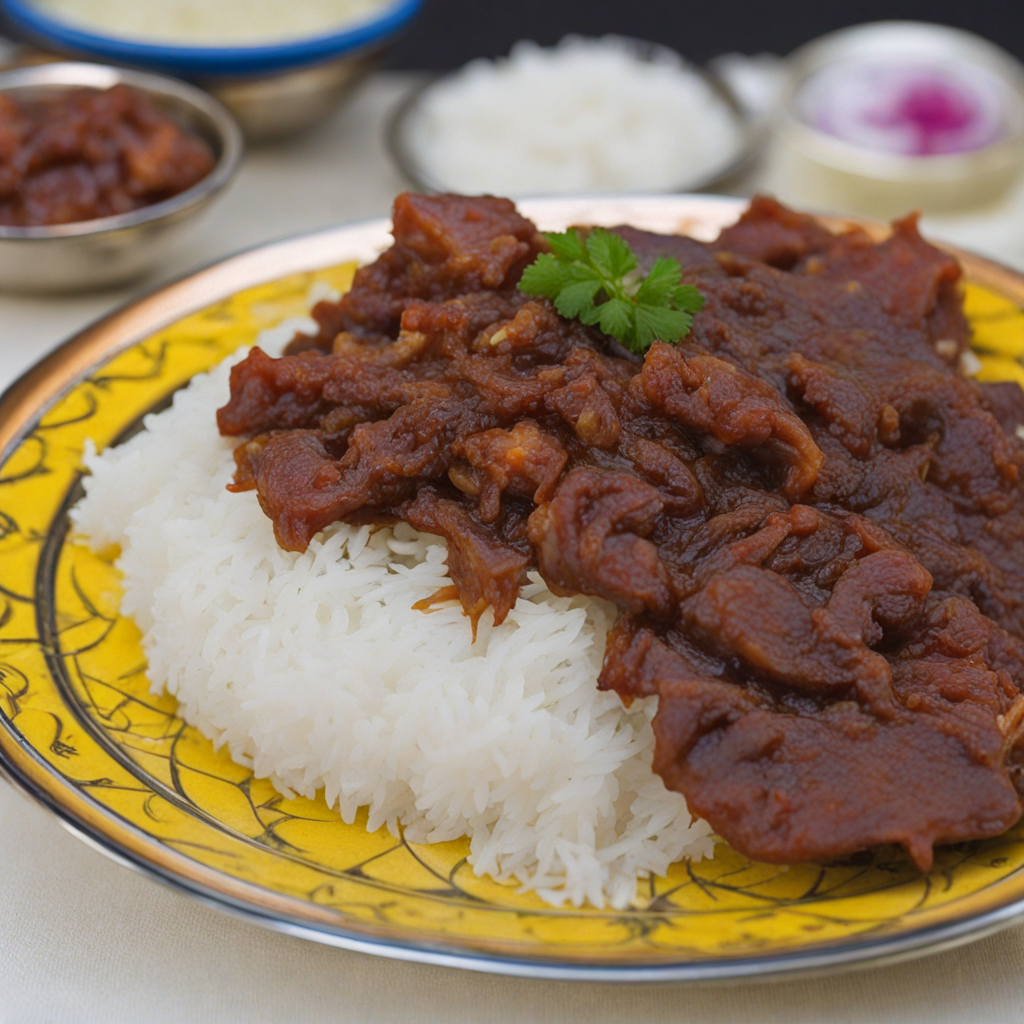Baasto
Baasto is a delightful dish hailing from Djibouti, known for its comforting blend of flavors and textures. At its core, Baasto consists of pasta, typically spaghetti, which is cooked to a perfect al dente. What sets this dish apart is its rich, aromatic sauce, often featuring a medley of spices that reflect the vibrant culinary traditions of the region. The sauce is usually made with tomatoes, onions, garlic, and a variety of spices such as cumin and coriander, providing a warm, fragrant base that envelops the pasta beautifully. In addition to the pasta and sauce, Baasto is often accompanied by a protein, which can range from tender pieces of marinated chicken to savory beef or even fish. This addition not only enhances the dish's heartiness but also contributes to the complexity of flavors. The proteins are typically seasoned and cooked separately, then combined with the pasta and sauce just before serving, allowing them to meld together harmoniously. The dish is sometimes garnished with fresh herbs, adding a burst of color and freshness to the plate. What makes Baasto truly special is its communal nature, often served in large portions meant to be shared among family and friends. The combination of the comforting pasta, the savory sauce, and the succulent protein creates a satisfying meal that is both filling and flavorful. Enjoying Baasto is an experience that transcends mere eating; it's about gathering, sharing, and savoring the diverse tastes that Djibouti has to offer.
How It Became This Dish
The History of Basito: A Culinary Gem of Djibouti Basito, a beloved dish from Djibouti, encapsulates the essence of the region’s diverse cultural tapestry and its rich culinary heritage. The name "Basito" is derived from the Arabic word "basta," which means "to spread" or "to layer," a fitting description for this delightful dish that has woven itself into the fabric of Djibouti's gastronomy. Origins of Basito The origins of Basito are deeply intertwined with the history of Djibouti, a small nation located at the southern entrance of the Red Sea, where the Arabian Peninsula meets the Horn of Africa. Djibouti's strategic location has made it a melting pot of cultures, with influences from Arab, African, and French cuisines. This amalgamation is reflected in Basito, which showcases the region's agricultural bounty and the culinary practices of its people. Historically, Djibouti has been a trade hub, with spices and ingredients flowing in from distant lands. The use of grains, legumes, and spices in Basito can be traced back to the ancient trade routes that passed through the region. As merchants and travelers brought their culinary traditions, they mingled with local practices, giving birth to hybrid dishes like Basito. The Ingredients of Basito At its core, Basito is a layered dish made primarily from rice, lentils, and meat, often flavored with a variety of spices. The dish can vary greatly in its preparation and presentation, reflecting personal and regional preferences. The typical Basito preparation begins with the selection of high-quality basmati rice, which is known for its long grains and fragrant aroma. The lentils, often split yellow or green lentils, add a nutty flavor and a rich source of protein. The meat, usually chicken or goat, is marinated in a blend of spices such as cumin, coriander, turmeric, and cardamom, which not only enhance the flavor but also pay homage to the spice trade that has shaped Djibouti’s culinary landscape. In addition to these staples, Basito often incorporates vegetables such as carrots, potatoes, and onions, which contribute to the dish's nutritional value and texture. The cooking method involves layering the ingredients in a pot and allowing them to steam together, creating a flavorful and aromatic dish that is both comforting and satisfying. Cultural Significance Basito is more than just a meal; it is a symbol of community and hospitality in Djibouti. Traditionally, this dish is prepared for special occasions, family gatherings, and celebrations, making it a centerpiece for communal feasting. When served, Basito is often placed in the center of the table, allowing diners to gather around and share in the experience of eating from a communal dish—a practice that reinforces family bonds and social connections. In Djiboutian culture, food plays a significant role in social interactions and rituals. The act of sharing Basito is an expression of generosity and warmth, and it is customary for hosts to ensure that their guests are well-fed. The preparation of Basito often involves collaboration among family members, with each person contributing to the cooking process, further fostering a sense of togetherness. Development Over Time As Djibouti has evolved over the years, so too has the preparation and presentation of Basito. The dish has adapted to modern tastes while maintaining its traditional roots. With the influx of globalization and the influence of international cuisine, Basito has seen variations that incorporate non-traditional ingredients and cooking methods. For instance, some contemporary interpretations of Basito include the use of quinoa or different types of rice, reflecting a growing awareness of health and nutrition. Additionally, chefs in Djibouti's urban centers have begun to experiment with plating and presentation, elevating Basito to a more refined dining experience while still honoring its rustic origins. Moreover, the rise of social media has allowed for a renewed interest in traditional dishes like Basito, as food enthusiasts and home cooks share their recipes and experiences online. This digital age has helped to preserve the cultural significance of Basito, ensuring that future generations appreciate and carry on this cherished culinary tradition. The Global Context In a broader context, Basito exemplifies the global movement towards recognizing and celebrating traditional foods as part of cultural identity. As the world becomes increasingly interconnected, there is a growing appreciation for the stories and histories behind dishes like Basito. Food historians and culinary enthusiasts alike are exploring the cultural significance of such dishes, promoting them as a means of preserving heritage and fostering cross-cultural understanding. In recent years, Djibouti has also gained attention as a travel destination, with food tourism playing a significant role in attracting visitors interested in experiencing the local cuisine. As travelers seek authentic culinary experiences, dishes like Basito are showcased in restaurants and food festivals, introducing a wider audience to Djibouti's rich cultural heritage. Conclusion In conclusion, Basito is a remarkable dish that embodies the history, culture, and traditions of Djibouti. Its origins are rooted in the region's rich agricultural practices and the diverse influences of trade and migration. As a symbol of community and hospitality, Basito serves as a reminder of the importance of food in bringing people together. Over time, Basito has evolved while remaining a cherished staple in Djiboutian households. Its journey reflects the broader trends of globalization and the growing appreciation for traditional foods. As Basito continues to be enjoyed and celebrated, it stands as a testament to the enduring power of food as a cultural connector, bridging generations and fostering a sense of belonging. With every bite, one can taste the history, the culture, and the love that goes into this exceptional dish, making Basito a true culinary gem of Djibouti.
You may like
Discover local flavors from Djibouti







